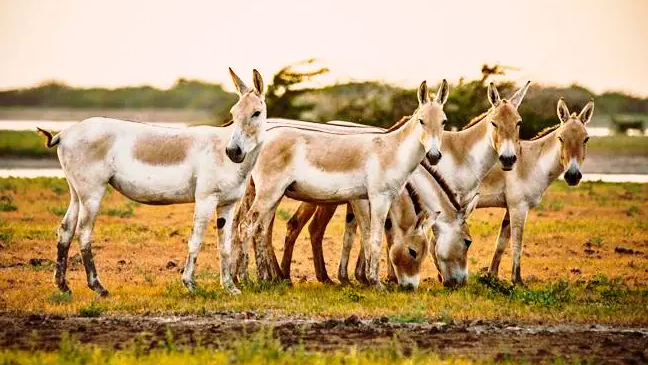‘Kutch nahin dekha toh kutch nahin dekha’ the one liner by Bollywood hero Amitabh Bacchan in one of the programmes showcasing ‘Vibrant Gujarat’ in the media circles is a world in itself. True if you have gone to Gujarat and haven’t seen Kutch then you have not seen much in life. The pungent smell of air combined with a vast emptiness is what hits any new comer as soon as he/she crosses Viramgam on railway line going from Ahmedabad—Sanad—Malvan—Dharangadhra axis. Even otherwise coming from a south –westerly direction with Surender nagar as the last district HQ of this arid region one can make out the topographical layout and its uniqueness that identifies itself with the ‘LRK’—(Little Rann of Kutch). Thick thorny bushes bordering both sides of the elevated road while the landscape changes to a flat and parched earth extending as far as the eye could see is what a tourist should brace himself to.A little or no vegetation and the vast emptiness looks quite intimidating to a first timer to this unique place in India.
Though almost everybody is aware of ‘Rann of Kutch’ most of us mistake the ‘LRK’ aka Little Rann of Kutch’ as part of the ‘Great Rann of Kutch or simply called as ‘Rann of Kutch’. Nothing can be farther from truth. In fact the LRK sustains such a wide and rich bio-diversity which till date remains unique to the region. Though it is contiguous to the Great Rann of Kutch, the LRK should not be confused with the former. I have had in the past numerous chance encounters to venture into the LRK region by virtue of being posted at Dharangadhra in early 2000 which functioned as the base for an avid traveller to further venture deep into the Rann area. Though LRK supports a variety of flora and fauna ,but the one which outshines everyone else is the native of this arid ecosystem i.e the Indian wild Asswhich roams with in the protected Indian wild ass sanctuary(IWAS) ,established in the year 1973 covering a total area of 4954 Sqkms. In the Kutchi language the Indian wild ass is called as ‘Ghorkhur’ and its scientific name is ‘Equushemionuskhur. IWAS is the only region in India where there are still such species living because unlike donkeys and its relative the horse, the wild ass was never successfully domesticated.
Feral populations also survive in similar types of ecosystems in Pakistan& Iran and in the vast steppes of the central Asian countries such as Mongolia and china. As mentioned above, the saline plains of LRK are usually bone dry throughout the year ,but during monsoons they flood, creating marshlands with patches of elevated islands called as ‘Bets’. These Bets are supportive of grasslands where the Indian wild Ass graze with chinkaras and Nilgais. Since the marshy grasslands of LRK support jeeps as the preferred vehicle for commute I one fine day took my army Mahindra jeep with children in tow and entered LRK from Kuda village following the SH 147A all along from Virendragadh—Narali- Kuda. It’s the safest and surest way to enter the vast emptiness of LRK since it supports lots of landmarks all the way and makes it much easier for a driver to maintain his spatial orientation which is always under the threat of getting disoriented. Scanning the shimmering horizon with my armyfield binoculars I chanced upon to see a cluster of slow moving dots. But the problem of tracking these dots became a bit difficult since an equal number of dots appeared below the horizon due to the formation of a typical mirage thus adding to the confusion. Resting the eyes is the only solution rather concentrating all along with a landmark in the near vicinity as a referencepoint than getting frustrated with the elements of the nature.
This distant glimpse was my first and only sighting of the elusive wild ass as they grazed nonchalantly in the scorching afternoon heat. The driver of my jeep understood the need to take the jeep forward by a kilometer to have a better look at these wild asses which was an intelligent move by him since I could make out these dots getting smaller in size by the minute suggesting that they were moving further away from us. A tough and hardy animal, the Indian wild ass can survive extremes of weather with little water, since it is the sub species of the Asiatic wild ass which once roamed in the deserts of Saudi Arabia, Iraq, Jordan, Israel, Syria and Afghanistan. However the population of this animal has now dwindled and one sub species, the Syrian wild ass is now almost extinct. The Indian wild ass is one of the only 4 surviving sub- species of the Asiatic wild ass, the others being the Persian onager, the Tukmeniankulan and the Mongolian wild ass.
In addition to the Indian wild ass, the other animals found on these numerous Bets sometimes as small as a football field include the striped hyenas, wolves and foxes all operating under the cover of darkness ready to feed on the gullible wild asses. In particular a visitor will be taken in by the intrepid ways of such animals which are not at all seen during day time but lie in deep burrows due to searing heat only to become active once darkness abounds these bets. As for the wild asses, these are very shy by nature and graze around without even a rustle of leaf for a human to understand their moves. If disturbed they bolt off in a jiffy reaching a top speed of 80kms per hour and can easily outrun even a jeep in those marshy routes. This makes the wild ass very difficult to track. Often finding solace in herds of 100 to 200 these animals keep a tight pack when under danger with their flanks covered by strong males. This quality of theirs may have discouraged the Maharajas and the British colonialists from big game hunting. However in the world famous ‘Akbarnama’ written by Abul Fazal, there is an illustration of Mughal emperor Akbar hunting these wild asses using matchlocks.
Currently listed as ‘Near threatened’—IUCN, the previous census in 2009 estimated the population of this very animal as 4038 but still counting. In December 2014, the population was estimated at 4451 with further increase to a level of 4800 wild asses as of 2015.It is heartening to know that in 2020 the head count of this elusive animal had soared to 6082. Since the conservation efforts have picked up momentum in the last 3 years, stray populations of the animal have spilled over to ‘Nalsarovar bird sanctuary’, Banaskantha, surendernagar, Mehsana, Rajkot and Patan districts. In fact (GEER) Gujarat ecological education and research foundation has recommended that the Thar Desert in Rajasthan be developed as an alternative site for reintroduction of this elusive animal. My one day sojourn with children to LRK with my driver in tow who was our points man was worth the effort in the scorching salt plains of abode of the Indian wild asses, though having sighted the flock from a distance of about 300 yards, the sight remains permanently branded in my memory as one of rare of rare—Kutch nahin dekha toh kutch nahin dekha was proved wrong by our sojourn…
(The writer a retired army officer and a regular scribe can be approached on his email…[email protected]








